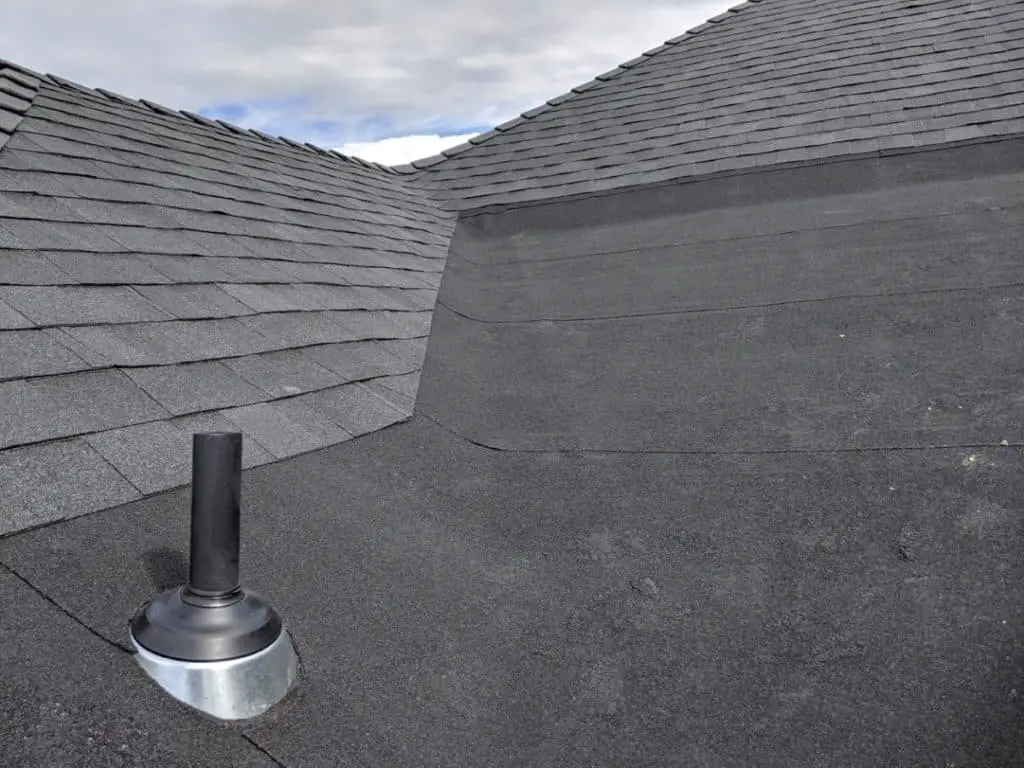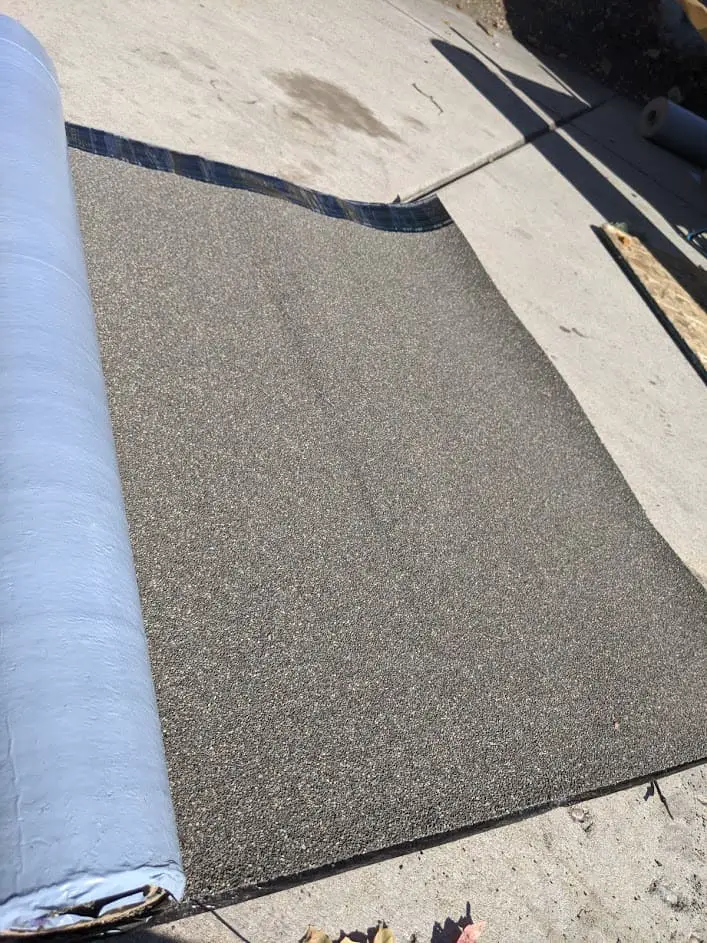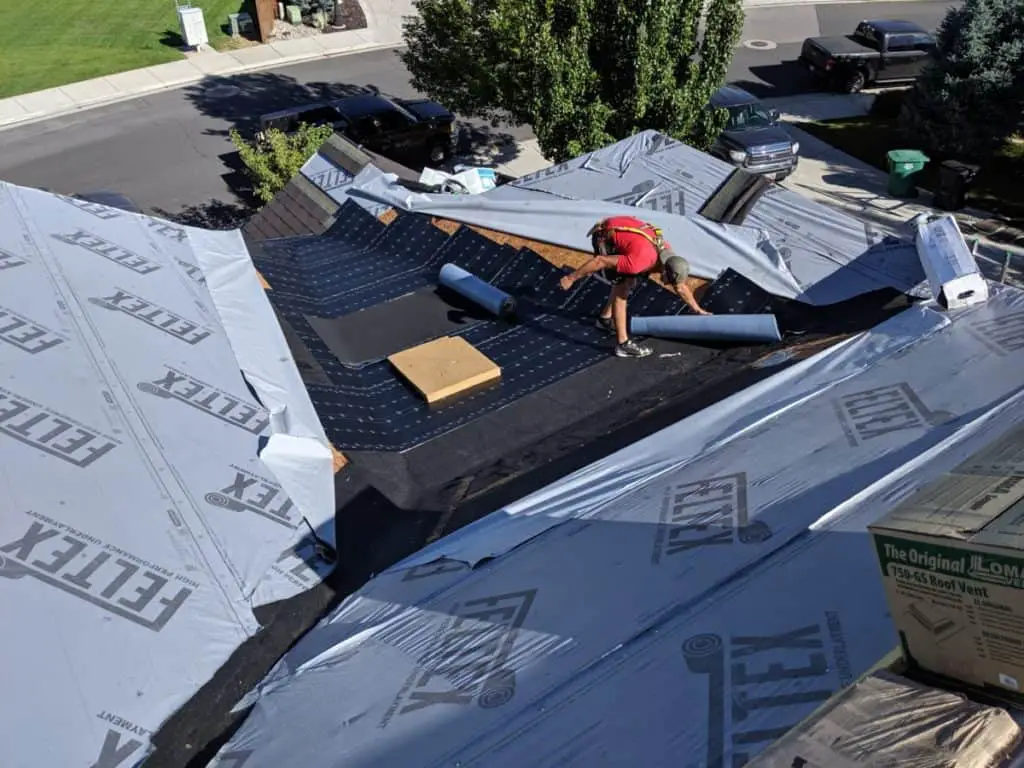
What is Modified Bitumen?
Modified Bitumen is a 2-part low slope roof system that is made when polymers are added to asphalt to change its properties.
The 2-part system consists of a base layer and a cap layer.
The base layer provides waterproofing and a surface for the cap to bond to. It is made up of a bitumen covered membrane which is composed of either:
- Fiberglass
- Non-woven Polyester
- or Composite, which is a combination of the two above.
The cap layer is placed above the base and is composed of a similar bitumen covered membrane but instead, the top surface is covered in granules much like an asphalt shingle.
Modified Bitumen is installed in one of three ways:
- Self-adhesive: This means that each layer has a sticky backside that is covered in plastic. Upon removal fo the plastic the layers stick down and seal when the sun hits it.
- Heat adhesive/welded: This usually involves a propane torch to melt the bitumen and seal it together. SBS and APP act differently when heated.
- Cold adhesive: Bitumen that is liquid at room temperature is used. This reduces potential fire risk and toxic fumes that can come from the heat adhesive.
Worried About Doing the Work Yourself?
I recommend finding a professional roofing contractor through our trusted partner Home Advisor because they allow you to get up to 4 quotes for free. This allows you to compare and choose the best roofing professional for your needs. Check them out by clicking this link.
There are two main types of Modified Bitumen SBS and App:
SBS
- Stands for: Styrene-Butadiene- Styrene
- It can be considered as the “Rubber Asphalt”.
- It’s more flexible and elastic than APP.
- Melts into a gooey paste.
APP
- Stands for: Atactic Polypropylene
- It can be considered as the “Plastic Asphalt”
- It’s more firm and brittle than SBS.
- Melts into a free-flowing liquid like hot wax.
Pros:

1.Style Options:
Modified Bitumen has many different style options. The color of the granules on the cap sheets can vary to match any color of shingles. The cap layer is like a roll of one giant shingle.
2. Temperature Resistance:
Modified Bitumen has resistance to low temperatures. It can withstand temperatures as low as -22 degrees Fahrenheit or -30 degrees Celsius without cracking or breaking. In these temperatures, the material can still remain flexible.
3.Fire-Resistance:
Modified Bitumen can be rated up to a Class A fire rating which is the highest fire rating. However, there is a disadvantage associated with the fire rating.
4.Price:
The price varies depending on how the material is installed but an estimated range is about $150 – $250 per square. This is slightly more expensive than Asphalt shingles but more affordable than TPO. If you want to compare the prices of 17 different roof materials you can follow this link.
5.Cold Adhesive Options:
Modified Bitumen can be applied using a cold adhesive or a self-adhesive. This has many advantages because it reduces fire risks of the torch heated method and it doesn’t release any toxic fumes into the air while being installed.
6.UV Resistant:
Modified Bitumen is UV resistance making it durable against the sun’s radiation. This can help to reduce energy costs, especially if lighter colors or more reflective top coatings are used.
7.Versatile:
Modified Bitumen is versatile meaning that it can be used for both commercial and residential roofs. From what I have seen, it is most commonly used in conjunction with other roofing materials like asphalt shingles. By placing modified bitumen on the low slop parts of the roof and regular shingles on the steep parts of the roof they match perfectly creating the next roofing “eye-candy”.
8.Recyclable:
Some of the materials in Modified Bitumen can be recycled. Sometimes bitumen roofing products like Asphalt shingles can be recycled and used to construct new roads.
9.Sealed System:
No matter what type of method was used to install the modified bitumen they all have on thing in common, that is a good seal. The modified bitumen seals down to the roof so there are no seams. This makes it waterproof and resistant to leaks.
10. Easy To Install:
Modified Bitumen is easy to install. The sheets can easily be rolled out across the roof. The variety of installation methods self-adhesive, cold adhesive, or hot mopping allows contractors to pick the best method for them and their clients.
Cons:

1. Fire-Resistance:
Although it has a class A fire rating, it doesn’t last as long as some other roof systems. The fire-resistance level will usually only last about 5-10 years especially if it has been damaged. To counter this, you may choose to resurface the material restoring it back to a Class A fire rating.
2.Fragile:
Modified Bitumen is not good for areas that get heavy foot traffic. It can be easily damaged from walking on it, especially if it is warmed by the sun. If roofers aren’t careful, they may accidentally damage the material while installing it underneath the hot sun.
3.Impact Damages:
Modified Bitumen is not as resistant to impact damages from falling branches or hail as other roofing systems are.
4.Life Expectancy:
The expected lifespan of Modified Bitumen is one of the lowest out of all the roofing materials. It has a life span of about 10 – 20 years even less if it gets damaged.
5.Fumes:
When Modified Bitumen is applied using the heated torch method it releases harmful fumes. After installation, the stinky odor of the new roof may last for a few days.
6.Puddling:
If there isn’t a proper drainage system on a flat roof, water will puddle or collect on the surface. When this occurs, Modified Bitumen will wear down faster than other flat roof types like TPO or PVC.
Alternative Options:
If Modified Bitumen doesn’t sound like the right kind of roof for you. There are at least 6 other options available for low slope/flat roofs that I have placed in a nice little chart below with links to other Pros & Cons lists for that material.
If you are interested in other roofing options I recommend you take a look at this article which I spent several months writing. It is a complete guide where I explain about 17 different types of roofing materials that are used today. You can read the article here.
This chart table shows the 6 other options for low slope roofs.
| Type | Description |
|---|---|
| Built-Up Roof | Built-Up Roof (BUR) is made up of multiple layers alternating between fabric material and bitumen (asphalt). Finally, the last layer is topped with rocks or gravel. Click Here to Learn More about Built-Up Roof. |
| EPDM | EPDM stands for Ethylene Propylene Diene Terpolymer. It’s a rubber-based material. Click Here to Learn More about EPDM. |
| TPO | TPO stands for Thermoplastic Polyolefin. This is a single-ply flat roof system that the newest of all the flat roof systems. Click Here to Learn More about TPO. |
| Spray-On Roof (SPF) | Spray-On roof has been around since 1964 and involves spraying layers of polyurethane and silicone. Click Here to Learn More about Spray-On Roof. |
| PVC | PVC stands for Polyvinyl Chloride and is made up of ethylene and chlorine which are derived from processed petroleum or natural gas and salt respectively. Click Here to Learn More about PVC. |
| FleeceBack | FleeceBack roof system is a Fleece material made out of polyester that can be added to the underside of EPDM, PVC, or TPO. It is adhered to the surface of the roof using 2-part fast adhesive foam. Click Here to Learn More about the FleeceBack roof system. |
Related Questions:
What is modified bitumen made of? Modified Bitumen is made out of asphalt-covered membranes. The reinforced membranes are made out of:
- Fiberglass
- Non-woven Polyester
- Composite, which is a combination of the two above.
Sometimes granules are added to the top surface to give it more strength and durability.
Is modified bitumen roof good? Modified Bitumen is a good roof if it fits your needs. It lasts about 10 – 20 years and looks great when used with asphalt shingles. However, it is not good for roofs that experience heavy foot traffic.
